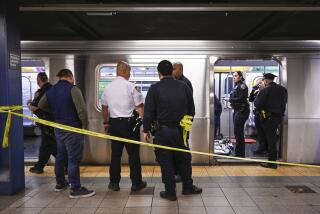Restaurant Posters on Choking Hit : Heimlich Challenges Initial Procedure
- Share via
Emergency first-aid posters displayed by law in more than 75,000 California restaurants give erroneous advice that may harm choking victims, the originator of the Heimlich maneuver has charged.
The American Red Cross and the American Heart Assn. deleted the disputed choking first-aid step from their standardized emergency procedures last summer, and U.S. Surgeon General C. Everett Koop issued a statement last October condemning the disputed first-aid practice--the use of blows to the back as the first step in assistance to a choking person--as “hazardous, even lethal.”
Depicts Both Methods
The official California poster depicts both the accepted Heimlich maneuver--also called the abdominal thrust--as well as the discredited back-slap method.
But the California Department of Health Services says it does not plan to start work on a program to recall and replace the poster for at least a month. Inaction by the health department also appears to involve confusion among Sacramento officials over whether the American Red Cross or the American Heart Assn. is responsible for revising national choking first-aid policy. A top health department official said Monday the agency is awaiting official notification from the Red Cross, while the Red Cross said the heart association is the organization officially empowered to recommend revisions.
Renewed Controversy
The renewed controversy over choking first aid represents the latest development in an ongoing dispute between Dr. Henry J. Heimlich, originator of the first-aid technique that bears his name, and national first-aid groups. The controversy has been going on since the late 1970s.
For several years, Heimlich and other researchers have maintained that if a person begins to choke or gag on a piece of food--or any other foreign object--lodged in the throat, slapping the victim on the back only drives the foreign body farther and more tightly down the windpipe. The dispute flared periodically until the heart association’s emergency cardiac-care committee agreed last July to delete the back-slap provision from hundreds of thousands of pamphlets, posters and other materials distributed nationwide.
The step--which the committee said was taken only to simplify training in first-aid techniques and not because the back slaps were dangerous, per se--had appeared to end hostilities between Heimlich and the national groups. A final, official report of the new action is expected to be published sometime next month in the Journal of the American Medical Assn.
But in mid-October, 10 days after Koop’s office issued the official statement condemning back slaps for choking victims as life threatening, Heimlich wrote to Gov. George Deukmejian urging that California move immediately to revise the restaurant posters.
Posters Displayed
The posters must be displayed somewhere in each of the state’s restaurants, according to Stuart Richardson, chief of the health department’s food and drug branch. Most eateries display the posters on employee bulletin boards, Richardson said, where restaurant workers can quickly refer to them if an emergency arises.
In December, Dr. Kenneth W. Kizer, director of the state health department, replied to Heimlich’s protest to Deukmejian, saying no steps would be taken in California until the Red Cross made an official announcement of the change in procedure--which was widely reported in the press at the time the new practice was designated at a heart association conference in Dallas.
In a telephone interview, Heimlich, of Xavier University in Cincinnati, complained that inaction by state officials was perpetuating possibly deadly first-aid procedures. Heimlich noted that many California telephone directories publish similar, erroneous choking aid advice.
“Since when,” Heimlich demanded to know, “does the head of a (state) public health department have to wait for the American Red Cross, which has no official position, to decide what is safe and what it not safe?
“Here you have a state health department willing to wait for what already has been decided six months ago.
Lives Endangered?
“I would say that every day, the lives of otherwise healthy Californians are endangered by the possibility of choking to death because this action by the health department leaves millions of people informed to perform first aid that has been declared by the U.S. surgeon general to be dangerous and lethal.”
In a telephone interview Monday, Richardson said the state agency has been stalling so would-be rescuers trained in Red Cross and heart association techniques would not be confused by seeing conflicting advice posted in restaurants.
Upward Thrusts
The Heimlich maneuver involves a rescuer grasping a choking victim from behind with the rescuer’s hands clasped together at the bottom of the rib cage, between the navel and lower ribs. The rescuer gives one or more quick upward thrusts, attempting to expel the food morsel or foreign body.
In Los Angeles County in the 12 months ended July 1, 1984, coroner’s office statistics indicate 22 people died of food morsel choking. Two of the victims were children nine or under and the rest were men and women 30 and older.
More to Read
Sign up for Essential California
The most important California stories and recommendations in your inbox every morning.
You may occasionally receive promotional content from the Los Angeles Times.













